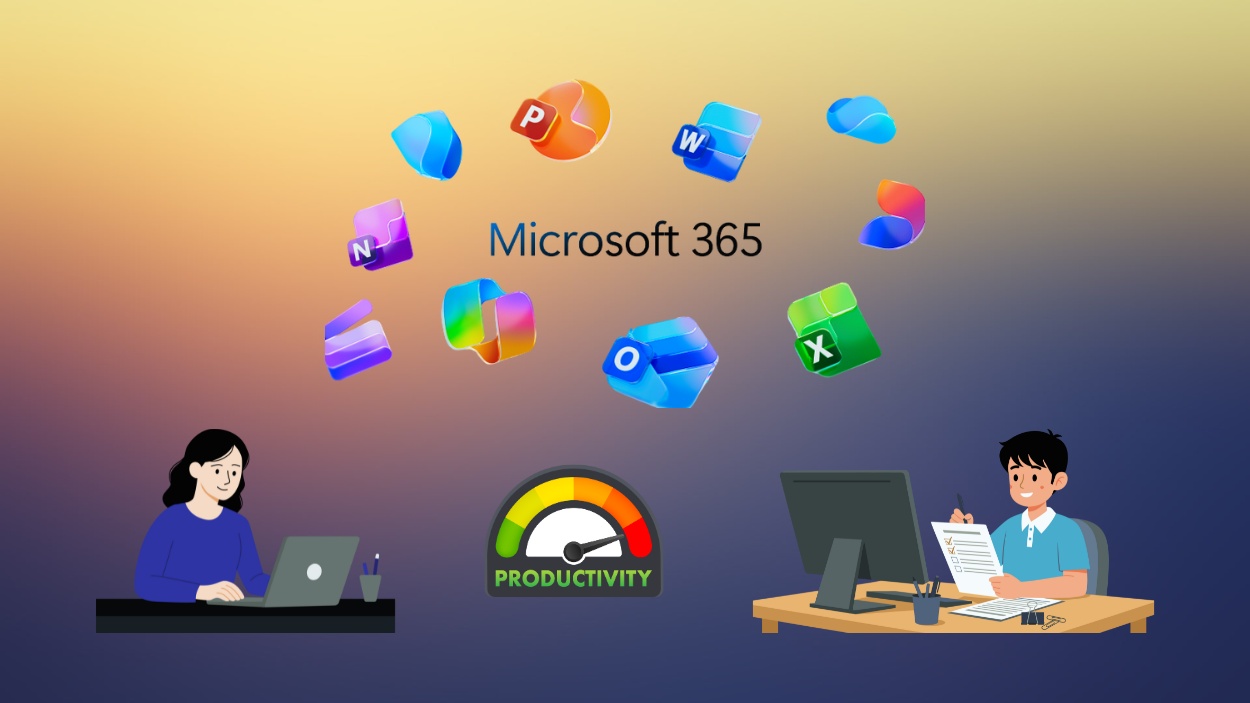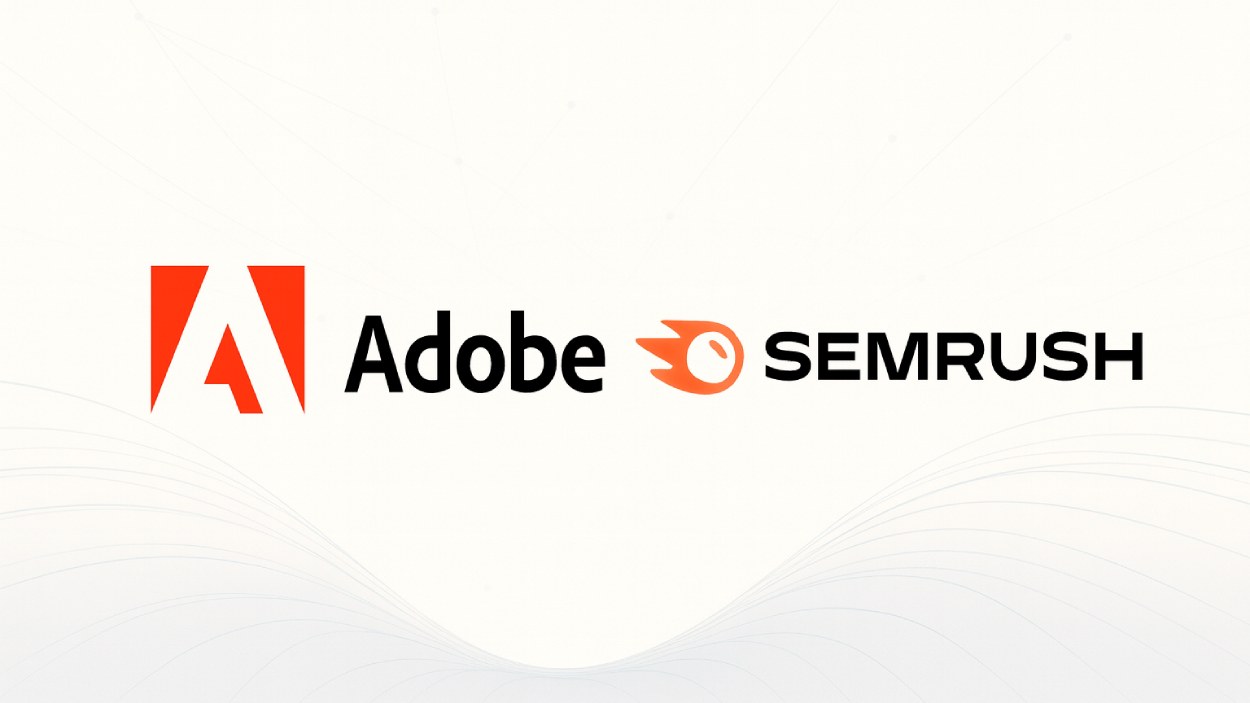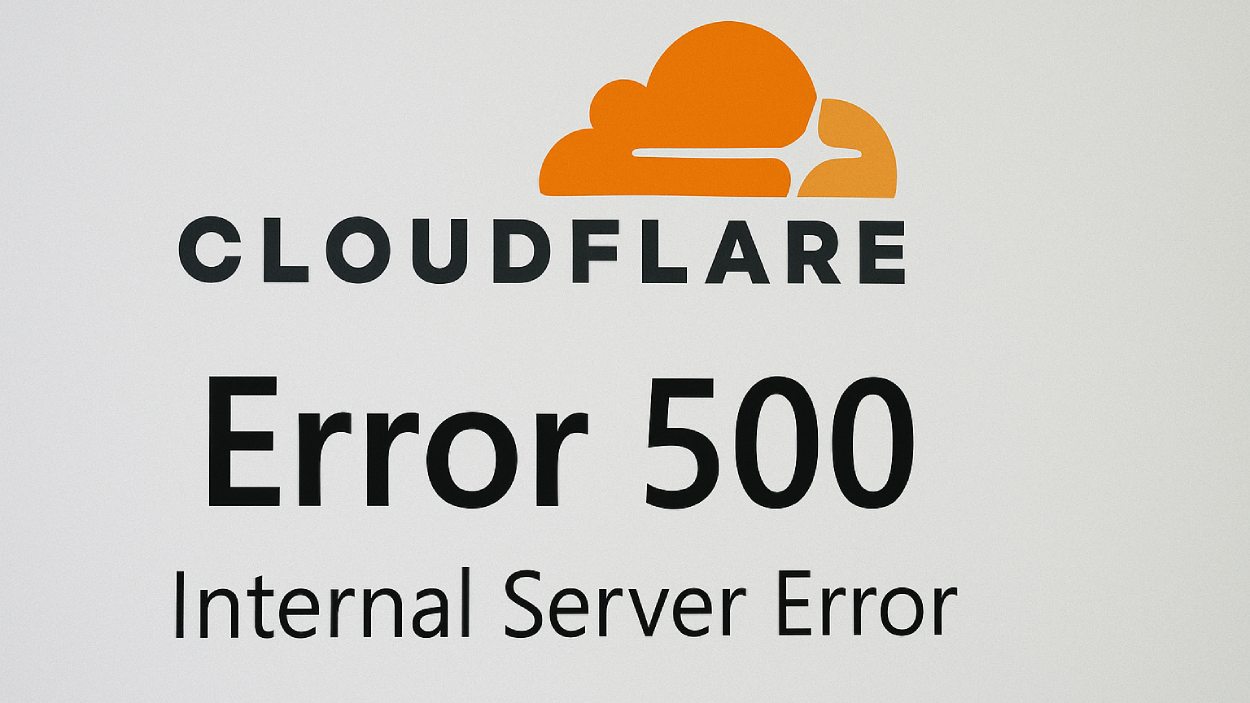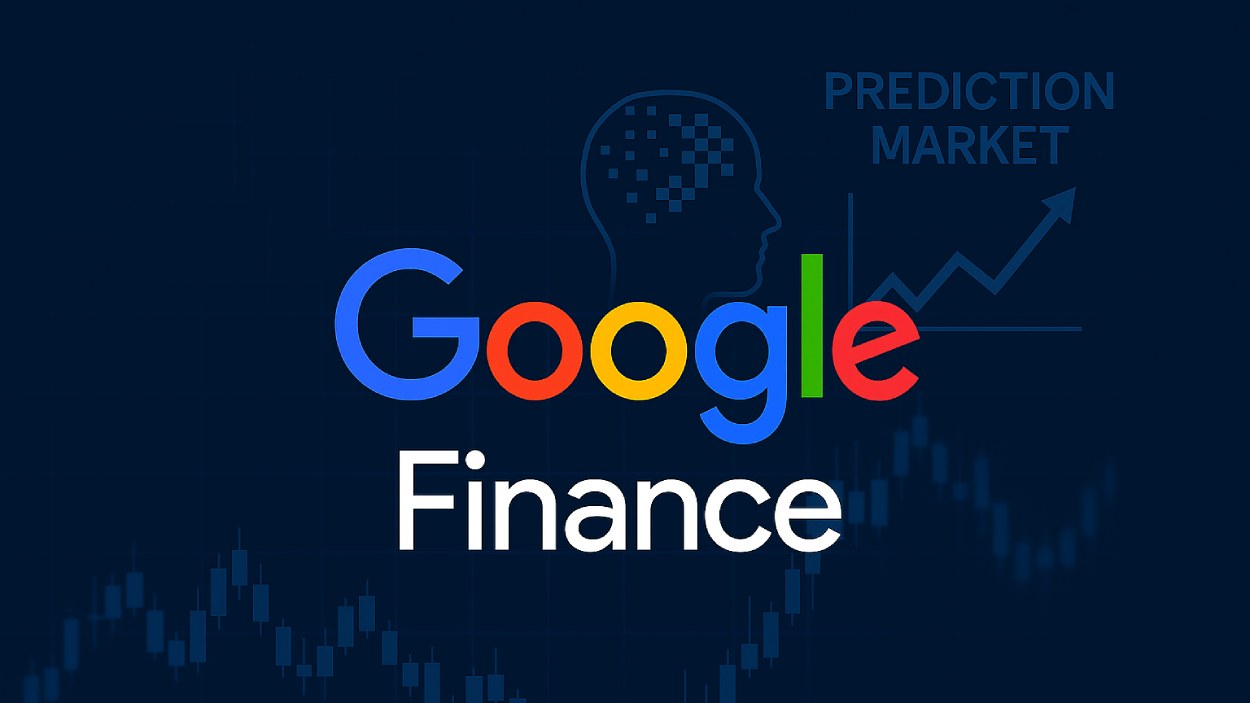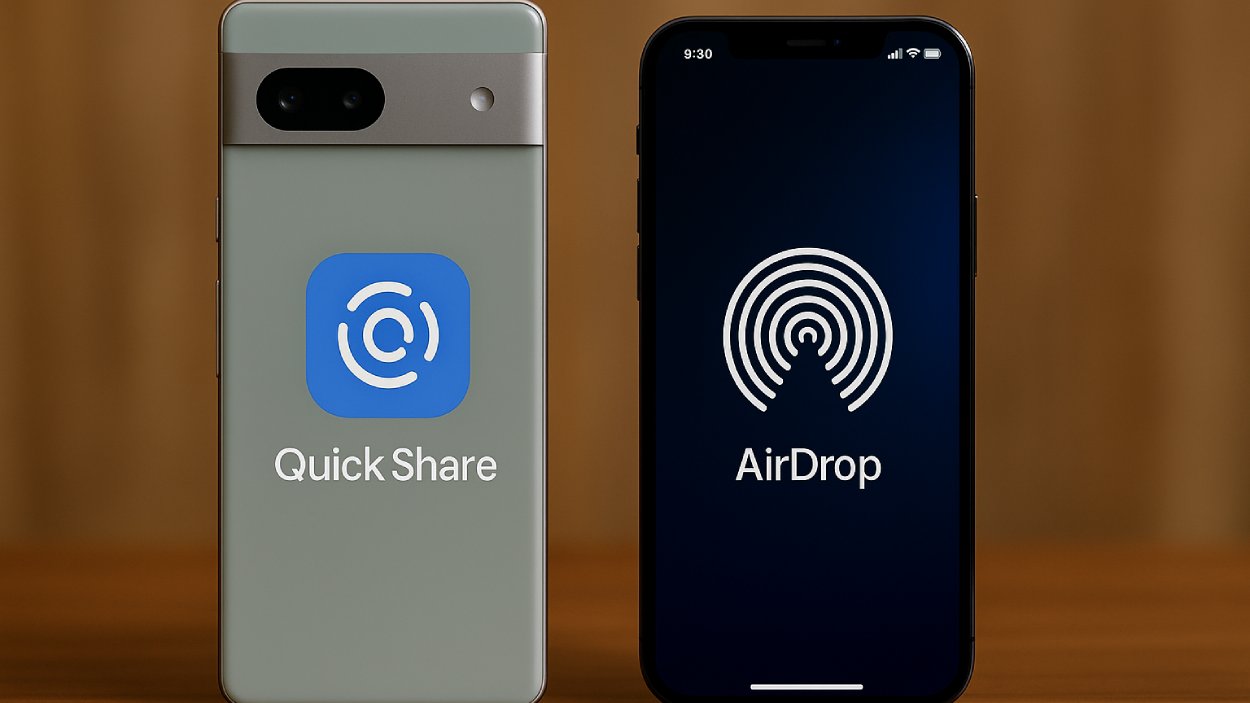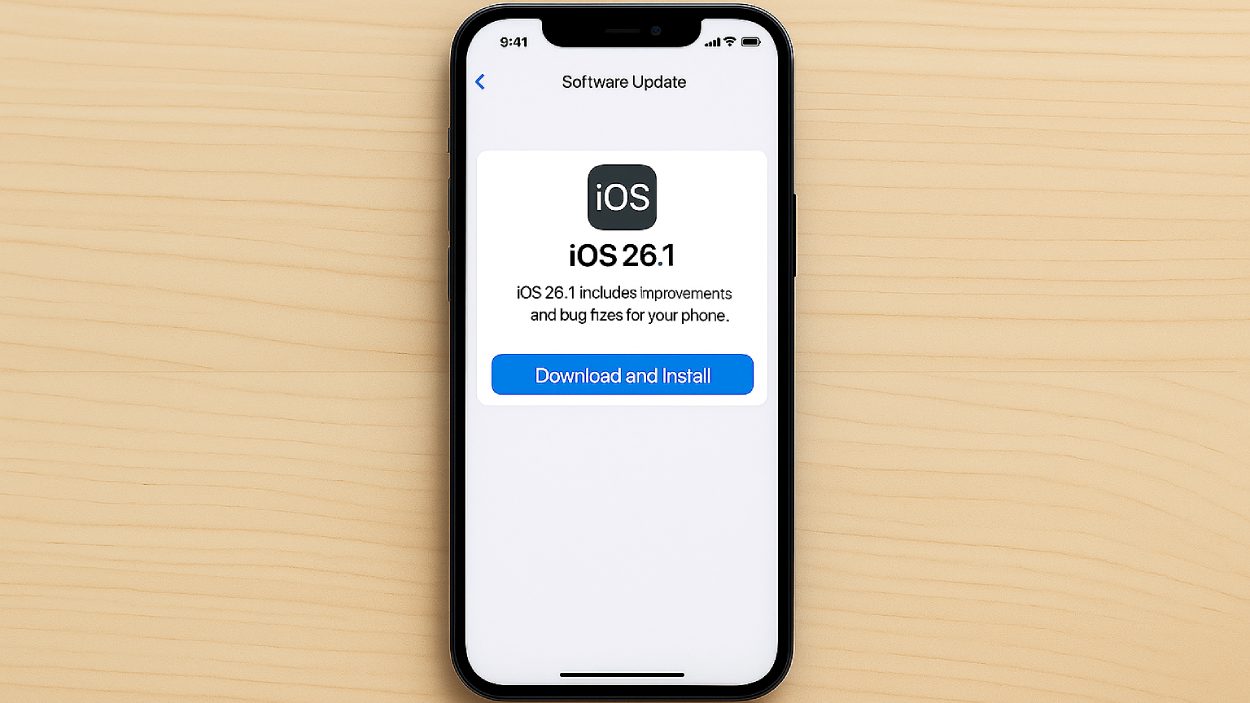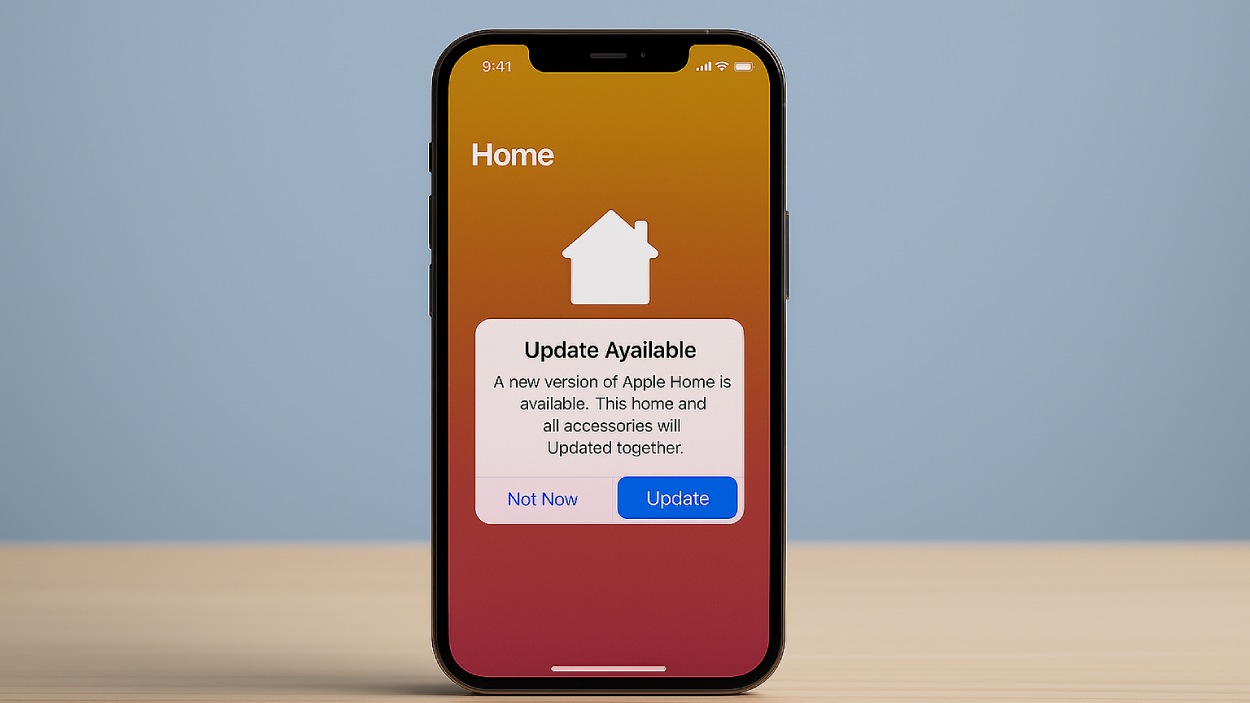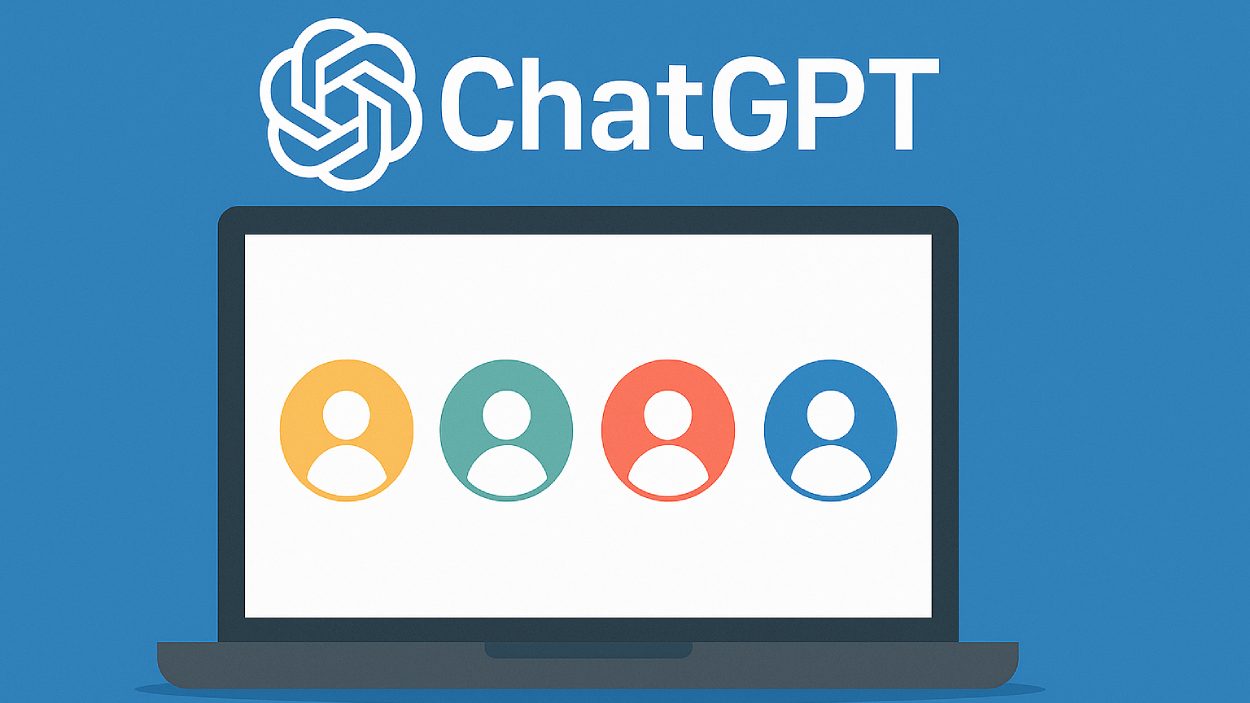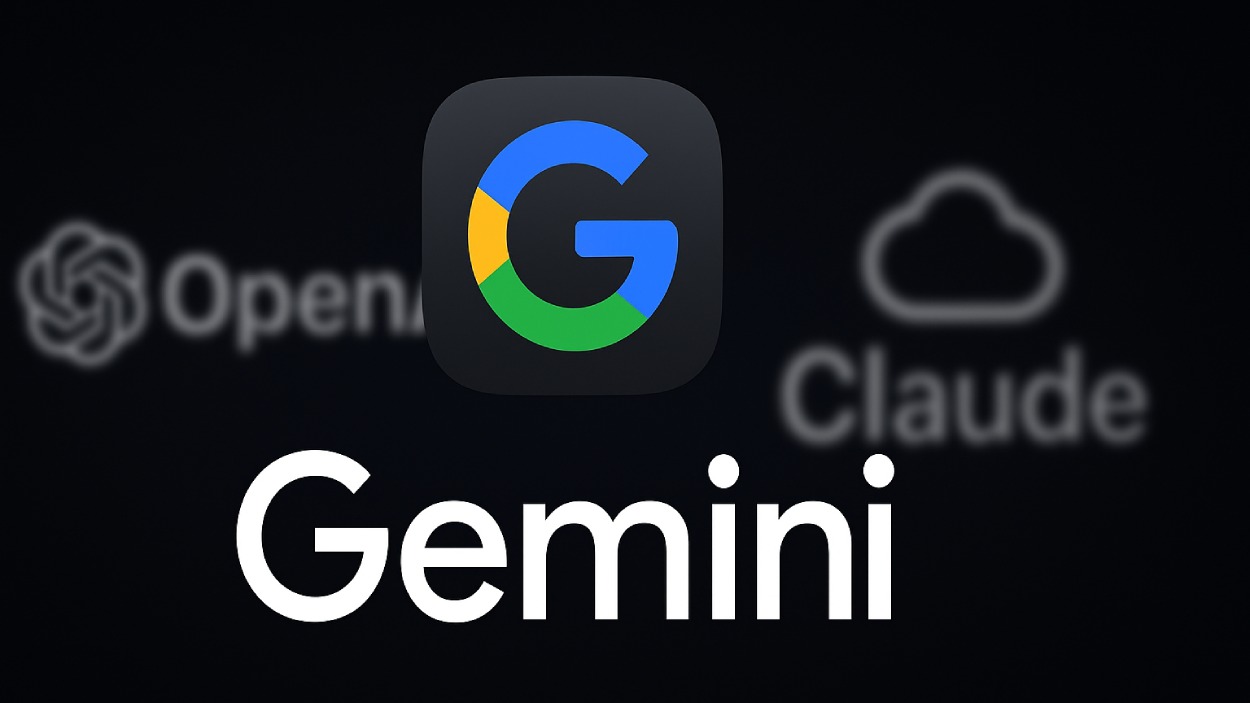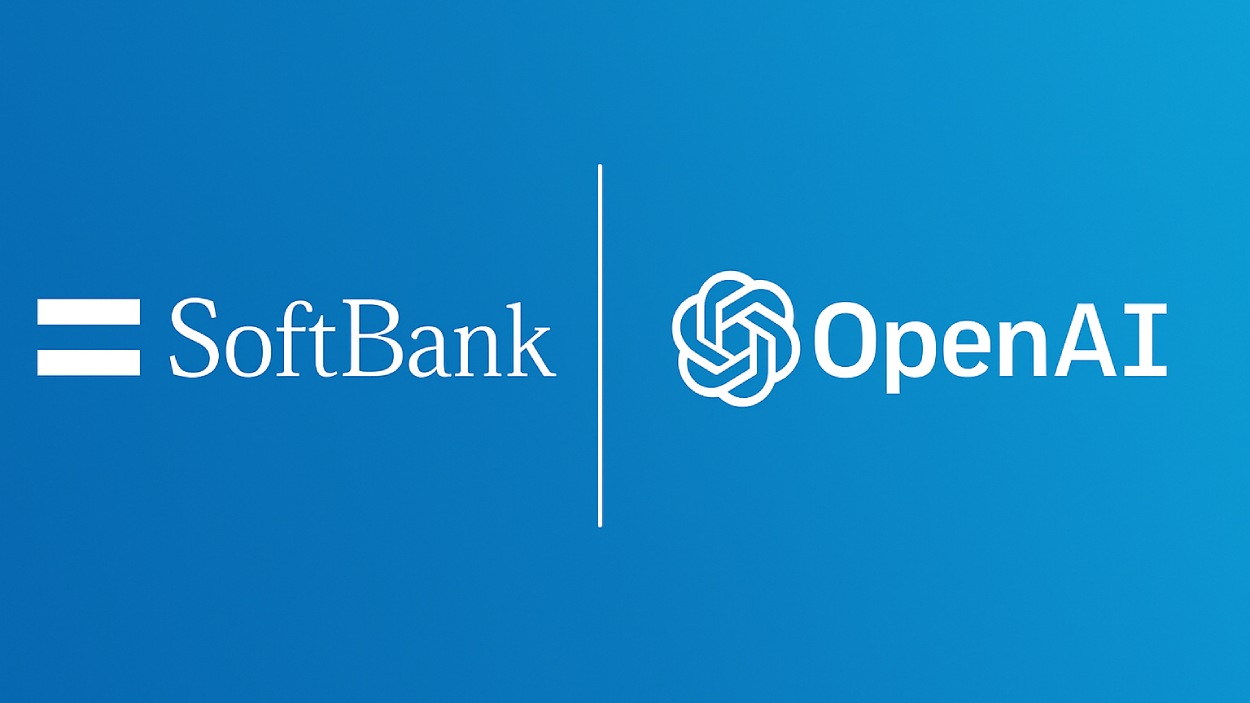At 8:03 a.m. every morning, Lisa fires up her laptop with a cup of coffee in hand. She types the first thing that crosses her mind, “weather this weekend”, into Google. She’s not alone. Every second, millions of users across the globe are doing the same thing. Whether it’s finding the best local sushi spot, checking sports scores, or researching complex topics, Google Search remains the invisible thread tying our curiosity to information.
In 2025, the role of Google has become even more vital in our digital habits. With new technologies like generative AI, voice search, and real-time personalization, Google isn’t just delivering answers, it’s predicting needs. Let’s break down the numbers behind this global information giant and discover how it’s evolving.
Editor’s Choice
- Google processes over 8.9 billion searches per day in 2025, up from 8.5 billion in 2024.
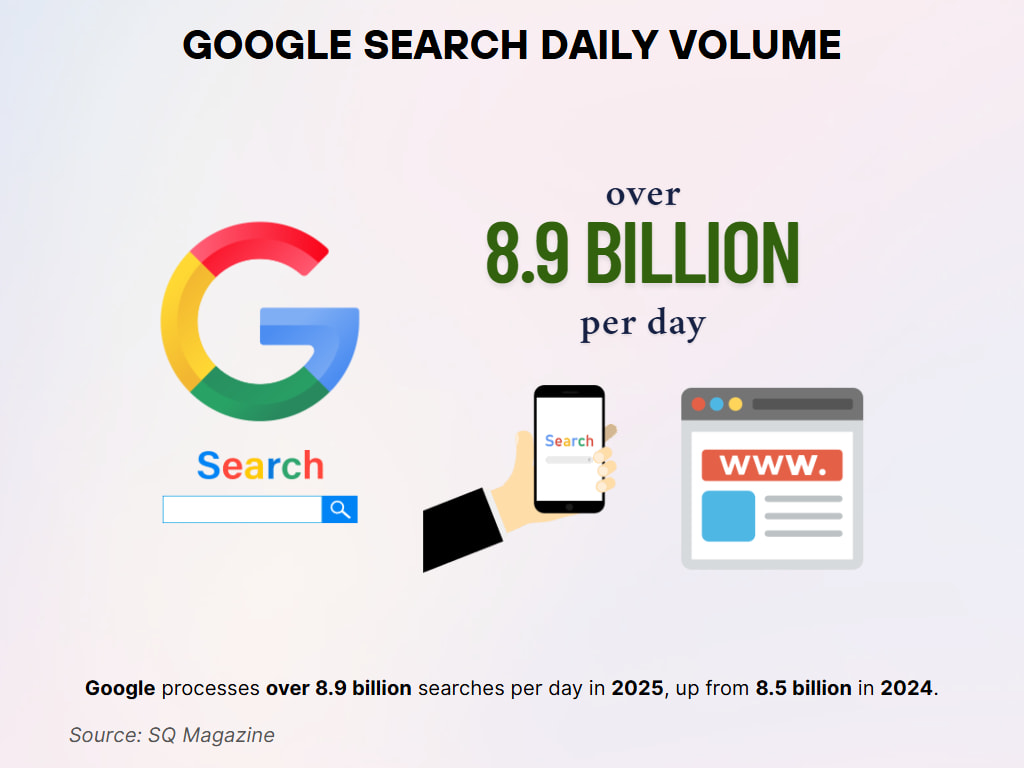
- As of Q1 2025, Google’s search engine holds a 91.55% market share globally.
- The average user conducts between 3 to 4 searches per day, but Gen Z averages over 5 daily searches.
- The “What is…” search format has grown by 18% YoY, driven by curiosity-led intent.
- Mobile searches made up 65.8% of all Google queries in early 2025.
- Google’s ad revenue from search reached $178.2 billion in 2024 and is projected to cross $190 billion in 2025.
- The most searched term globally in Q1 2025 was “AI tools for work”, a shift from 2024’s “World Cup.”
Total Number of Google Searches Per Day
- In 2025, Google handled over 8.9 billion searches daily, translating to 2.6 trillion searches annually.
- The average number of Google searches per second has grown to 103,000, up from 99,000 in 2024.
- By the hour, that’s approximately 370 million searches happening worldwide.
- Searches have increased by 4.7% YoY, marking Google’s highest growth rate since 2020.
- Mobile queries account for 65.8% of all search traffic, making smartphones the primary entry point.
- During major global events (e.g., elections or product launches), search spikes can exceed 200,000 searches per second.
- In the US alone, Google processes over 1.2 trillion searches annually, making it the most queried search engine nationally.
Google’s Search Engine Dominance
- Google controls over 91.5% of the global search engine market as of March 2025.
- In contrast, Bing holds 3.2%, Yahoo! has 1.3%, and DuckDuckGo accounts for 0.5% of global search traffic.
- On mobile devices, Google commands an even stronger presence at 96.3% market share.
- In the United States, Google’s desktop search share is 86.4%, but its mobile dominance is nearly 98%.
- Over 5.5 billion devices worldwide use Google Search as their default search provider.
- In educational institutions and government organizations, Google Search remains the default in more than 80% of US-based networks.
- Despite growing competition in AI search, Google has maintained a 4.6% annual growth in market dominance.
Global Voice Search Market Overview (2022–2032)
- In 2032, the market is forecasted to hit a peak of $112.5 billion. This marks a more than fivefold growth from 2022, with a CAGR of 19.2%.
- In 2022, the global voice search market was valued at $20.3 billion. This marks the starting point of a strong growth trajectory.
- By 2023, the market will have reached $24.2 billion. This increase reflects the rising adoption of voice-enabled technologies.
- In 2024, the market is forecasted to hit $28.2 billion. Continued investment in AI and NLP is fueling this expansion.
- For 2025, the market size is expected to be $35.1 billion. Voice assistants and smart devices are key drivers behind this surge.
- In 2026, the market is projected to reach $42.7 billion. Speech and voice recognition tools are becoming more embedded in daily tech use.
- By 2027, the value is estimated to grow to $49.8 billion. Businesses are increasingly integrating voice search to enhance user experience.
- In 2028, the market is set to cross $55.7 billion. This reflects a shift toward hands-free, voice-first digital interaction.
- For 2029, projections place the market at $66.4 billion. Enhanced voice AI capabilities are making systems more intuitive and accurate.
- In 2030, the market is expected to grow to $77.5 billion. Voice recognition plays a critical role in automation and accessibility.
- By 2031, the market size will likely reach $92.4 billion. The tech’s adoption is rapidly expanding across industries and regions.

Google’s Market Share in the Search Engine Industry
- As of Q1 2025, Google’s global market share sits at 91.55%, up from 90.67% in 2024.
- Android devices contribute nearly 70% of Google’s search traffic due to its ecosystem integration.
- In the Asia-Pacific region, Google controls over 92.1% of the market, despite regional alternatives.
- Europe shows a slight dip, with Google capturing 87.3%, influenced by regulatory diversification requirements.
- In North America, Google’s share is slightly higher at 93.2%, holding firm despite Bing’s AI push.
- On iOS, Google remains the default search engine for Safari, accounting for more than $18 billion in annual licensing deals.
- Emerging competitors like Neeva and Brave have market shares below 0.3% despite growing user interest.
Google Search Growth Rate
- Google’s total search volume grew 4.7% YoY in 2025 compared to 4.1% in 2024.
- In emerging economies, growth is faster, India and Indonesia saw 8.6% and 9.1% increases, respectively.
- AI-generated search suggestions have led to a 12.5% boost in daily interactions per user.
- The query length has increased, with average searches now containing 4.6 words, up from 4.2 in 2023.
- Google’s Knowledge Graph receives 700 million hits per day, a 6% rise YoY.
- Google Lens searches have grown 15% YoY, now exceeding 20 billion monthly queries.
- Google Trends reports that interest-based searches (e.g., “how to” and “near me”) have expanded by 9.3% YoY.
Search Engine Market Share: Overall vs Mobile
- DuckDuckGo has a niche but growing footprint, with 0.8% overall and 0.9% mobile market share. Its privacy-focused approach appeals slightly more to mobile users.
- Google dominates the market with a 92% overall share and an even higher 96% share on mobile. It remains the undisputed leader in search across all platforms.
- Yahoo holds a modest 2.8% overall share, dropping to just 1.8% on mobile. Its relevance continues to decline, especially among mobile users.
- Bing accounts for 3.9% of overall search visits but only 1.4% on mobile. Despite some presence on desktops, its mobile usage is significantly lower.

Most Searched Keywords on Google in 2025
- In Q1 2025, the top global search term was “AI tools for work”, overtaking entertainment-related queries.
- In the US, trending keywords include “IRS refund delay 2025,” “OpenAI ChatGPT-5,” and “housing market crash.”
- The fastest-rising search phrase was “how to use AI legally”, which grew over 4,200% YoY.
- Health-related searches still dominate, with “symptoms of long COVID” ranking in the top 10.
- “Taylor Swift tour 2025” and “Super Bowl halftime show” were among the most searched entertainment events.
- In tech, “iPhone 17 release date” and “Samsung Galaxy Fold 6” were the top product-specific terms.
- The most searched “how-to” query in the US? “How to file taxes with AI tools.”
Geographic Distribution of Google Search Users
- The United States leads with over 260 million active Google Search users.
- India is second, with approximately 840 million monthly users, many of whom rely on voice input.
- Brazil, Indonesia, and Mexico round out the top five with more than 100 million users each.
- In Africa, search activity has increased by 11.2% YoY, thanks to affordable smartphone access.
- European nations like Germany, France, and the UK account for over 240 million users combined.
- In rural regions globally, Google Go adoption has surged, driving 15% higher engagement.
- Google’s localization efforts have brought search in over 150 languages, serving over 90 countries effectively.
Organic vs Paid Search: Key Insights
- Paid search ads boast a 1.16% higher conversion rate than organic search, proving their edge in driving immediate action.
- 53% of all Google traffic comes from organic search, highlighting its vital role in visibility and reach.
- Businesses earn an average of $8 in profit for every $1 spent on Google Ads, showing strong ROI for paid campaigns.
- Moving up one rank in Google results can increase click-through rates (CTR) by 32.3%, making SEO efforts highly impactful.
- The top organic result gets clicked 37.7% more often than the top paid ad, indicating higher user trust in organic listings.
- Shockingly, over 96% of websites get zero traffic from Google, underlining the importance of effective SEO.
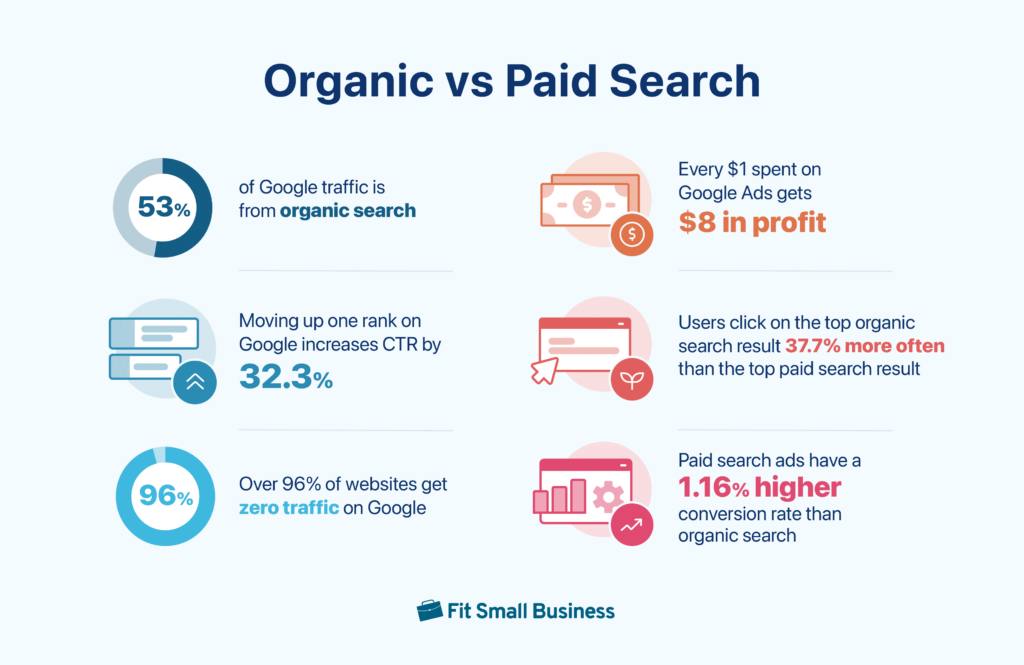
Desktop and Mobile Google Search
- As of 2025, 65.8% of all Google searches originate from mobile devices, while 30.2% come from desktops and 4% from tablets.
- Desktop search share has declined slightly, down from 32.7% in 2024, showing a continued mobile-first trend.
- The average mobile session duration on Google Search is 1 minute 28 seconds, compared to 2 minutes 7 seconds on desktop.
- Users on mobile click through to websites 9.7% less frequently than those on desktops.
- Android devices contribute to over 70% of mobile Google searches, with Chrome as the dominant browser.
- Mobile voice searches made up 21.4% of total mobile queries in 2025.
- Despite being smaller in share, desktop searches still lead in B2B and academic-related queries.
Voice Search Trends on Google
- In 2025, voice search accounts for 20.1% of all Google queries, up from 18.3% in 2024.
- Among Gen Z users, voice search usage is even higher, 34% say they use voice assistants daily.
- Google Assistant handles over 1.3 billion voice queries per month, integrating across Android and smart devices.
- “Near me” voice queries have grown by 19% YoY, especially in retail and dining.
- Smart speakers (Nest, Google Home) process 500 million searches monthly, with high traction in the US and Canada.
- In-car Google Assistant usage has increased 14% YoY, becoming a core tool for navigation and local search.
- Over 50% of voice searches are question-based, reflecting natural language preferences like “what,” “how,” and “when.”
Voice Assistant Usage on Mobile Phones in the US
- Alexa (Amazon) is used by 26% of mobile users. While popular in smart home devices, its mobile phone presence is significantly lower.
- Siri (Apple) leads the market with 90% usage on mobile phones in the US. It remains the most widely used voice assistant among smartphone users.
- Google Assistant follows with a strong 75% usage rate. Its integration across Android devices contributes to its widespread adoption.

Google Search Traffic by Industry and Sector
- Retail leads all industries in Google search traffic, making up 23.6% of total commercial intent queries.
- Healthcare-related searches account for 14.8%, with spikes during flu and allergy seasons.
- Travel queries saw a 9.1% growth YoY, particularly in last-minute bookings and visa requirements.
- Finance and banking terms hold 12.4% of total searches, largely driven by investment-related topics.
- Education and e-learning queries increased by 7.3%, with higher demand for online course platforms and certifications.
- Real estate searches have jumped 11.5%, especially in states like Florida, Texas, and Arizona.
- B2B tech services have a relatively smaller but targeted footprint, 4.6% of all search volume, mostly high-value leads.
- Sustainability-focused keywords (e.g., “eco-friendly packaging”) grew 13.2% YoY across multiple industries.
- Food and recipe searches have remained consistent, making up 8.3% of total traffic.
- The gaming industry saw a 17% surge in search interest, led by eSports and cross-platform titles.
Search Intent and User Behavior Patterns
- 60.5% of Google users in 2025 will conduct informational searches, showing a strong intent for learning or research.
- Transactional search intent (buy, sign up, subscribe) now accounts for 26.4%, up from 24.7% in 2024.
- Navigational searches (e.g., “Facebook login”) hold 13.1% of overall queries.
- Search abandonment has declined by 7.9%, driven by smarter suggestions and predictive autosuggest.
- Long-tail keywords have grown 9.4%, reflecting a shift toward more specific, conversational queries.
- Google Autocomplete is used in over 83% of typed searches, aiding quicker query formation.
- Repeat search behavior is up 5.1%, with users revisiting familiar queries weekly.
- The bounce rate from search to site has decreased across most verticals, especially with better alignment between snippets and results.
- AI-powered “multisearch” tools, allowing image + text input, are being used by 12% of users monthly.
- Searchers are more action-driven: CTR increases by 16.2% when rich results or featured snippets are present.
Key Google Search Stats Every Business Should Know
- 97% of internet users search online to find a local business, emphasizing the need for local SEO.
- Google Search holds a 91.47% global market share and serves 5.5 billion active Internet users.
- Around 99,000 searches per second are conducted on Google, totaling 8.5 billion searches per day.
- The most searched keyword on Google worldwide is “YouTube”, with a 1.4 billion search volume.
- Mobile devices account for 89% of Google search traffic, while desktops contribute 78%.
- Users typically use Google 3 to 4 times per day, showing frequent engagement with search.
- 63% of users click on Google paid ads, making it a key driver for online visibility.
- 53% of website traffic from Google comes through organic search, highlighting the importance of SEO.
- On the first page of Google results, 28.5% of users click on the first set of results they see.
- 81% of internet users go to Google to search for a product or service, showing high commercial intent.
- 80% of businesses use Google Ads to run PPC and digital ad campaigns.

Click-Through Rates on Google Search Results
- In 2025, the average CTR for position 1 is 27.6%, a slight drop from 28.1% in 2024.
- Positions 2 and 3 generate 15.8% and 11.4% CTR, respectively, showing steep declines beyond the top spot.
- Only 0.63% of users click beyond page one, highlighting the importance of ranking in the top 10.
- Featured snippets get 8.2% of clicks when shown, often cannibalizing the traditional first link.
- People Also Ask (PAA) boxes receive interaction from 46% of users, particularly on mobile.
- Meta titles that include a number (e.g., “Top 5 Tools”) outperform others by 14.7% CTR.
- In branded searches, homepage links attract 60%+ of all clicks, reaffirming navigational intent.
- Video-rich snippets now increase CTR by 18.6% on average, especially in how-to or product review queries.
- On average, users click on 1.68 results per search session, down slightly due to zero-click improvements.
- Google’s Knowledge Panel CTR is 6.3%, often driven by users looking for structured answers about entities.
Paid Search
- Google Ads generated $178.2 billion in search ad revenue in 2024 and is projected to hit $190.6 billion in 2025.
- The average Cost-Per-Click (CPC) on Google Search is $2.88, varying widely by industry.
- Industries like legal, insurance, and finance have CPCs over $10, the highest on the platform.
- Search ads account for 58.6% of Google’s total advertising revenue, surpassing display and YouTube.
- Conversion rates for Google search ads average 4.6%, with e-commerce and local services performing best.
- Smart Bidding adoption has increased to 92% among advertisers, relying heavily on AI-driven optimization.
- Mobile ad spending makes up 70% of the total search ad investment, reflecting consumer behavior.
- Local inventory ads have surged, growing 23% YoY, particularly for retail and hardware stores.
- Dynamic Search Ads (DSAs) now represent 16.4% of total ad formats used, increasing relevance in high-volume accounts.
- Advertisers using Performance Max campaigns see, on average, 22% better ROAS compared to traditional campaigns.
User Decision Time: Mobile vs Desktop Behavior
- Even in the 90–120 second range, 3% of mobile and 2% of desktop users are still making decisions, showing that mobile users are slightly more patient.
- 45% of desktop users make decisions within 0–5 seconds, compared to 33% of mobile users. Desktop users tend to decide faster.
- For the 5–10 second window, 20% of desktop users and 18% of mobile users make their choice, showing a slightly longer decision time on mobile.
- In the 10–15 second range, 9% of mobile users and 8% of desktop users take action.
- At 15–20 seconds, mobile users (9%) remain slightly more engaged than desktop users (7%).
- Fewer users decide after 20 seconds, with mobile at 5% and desktop at 4% between 20 and 25 seconds.
- Between 25 and 30 seconds, just 3% of mobile and 2% of desktop users make decisions, showing a drop in engagement.
- Interestingly, there’s a spike in mobile decisions at 30–45 seconds (9%), while desktop stays lower at 5%.
- From 45–60 seconds, decision rates drop to 4% on mobile and 3% on desktop.
- 60–90 seconds sees 5% of mobile users still engaging, compared to 3% of desktop users.

Google Ads Performance and Search Advertising Trends
- Click-through rates for Google search ads average 3.17%, higher on branded and localized keywords.
- ROAS for Google Ads in 2025 is approximately 4.5x, driven by better audience segmentation.
- AI-powered campaign creation tools like Performance Max are used by over 80% of Google Ads accounts.
- B2B campaigns are increasingly relying on intent data, resulting in 18% higher conversion efficiency.
- Shopping ads now receive 34.6% of all paid search clicks, led by mobile device traffic.
- Video ad extensions on search results are being tested with a pilot CTR of 2.4%.
- Advertisers are spending more on keyword segmentation, with broad match usage dropping by 11.2%.
- Customer Match and remarketing lists are now used in 72% of campaigns, improving ROI across verticals.
- Google Ads’ average impression share is 73.1%, although highly competitive keywords drop to 41-58%.
- AI-driven creative testing tools have reduced A/B testing time by up to 50% across campaigns.
Zero-Click Search Statistics
- As of early 2025, over 58.5% of Google searches result in no click, up from 57.2% in 2024.
- Featured snippets, PAA boxes, and instant answers are the primary causes of zero-click outcomes.
- Mobile sees more zero-click behavior, with 67.1% of queries not leading to site visits.
- On desktop, zero-click searches are slightly lower, at 47.3%.
- Weather, currency conversion, and sports scores are the most common zero-click verticals.
- Google Maps and Local Pack results absorb a large share, particularly for restaurant and service searches.
- AI-generated summaries are now tested for informational queries, expanding zero-click scope.
- Searchers under 35 are more likely to trust and use zero-click answers, according to user surveys.
- Publishers have begun optimizing for “brand mentions without clicks” to gain visibility within zero-click scenarios.
Google AI
- In 2025, over 85% of Google Search results are influenced by AI-driven ranking systems, including MUM and BERT.
- Google’s Search Generative Experience (SGE) is now available in over 120 countries, offering AI-summarized answers for complex queries.
- MUM (Multitask Unified Model) handles 1 in every 3 complex searches, particularly comparison or exploratory-type queries.
- Google AI models analyze billions of web pages daily, learning from content updates in near real time.
- Generative AI suggestions appear in 12.3% of mobile search results, especially for queries without a clear single answer.
- Google’s Gemini models now contribute to voice, image, and multisearch AI capabilities, improving contextual understanding.
- Over 40% of users engage with AI-powered features like autosuggest, image explanations, or semantic search daily.
- Developers and site owners are using AI-powered Search Console insights, introduced in 2025, to optimize site indexing faster.
- AI-generated shopping guides have rolled out for product-based queries, driving a 9.8% higher CTR compared to traditional listings.
Impact of AI on Google Search Algorithms
- Google’s core algorithm updates now include AI-layered relevance models, rolled out bi-monthly in 2025.
- The Helpful Content Update is now fully AI-enforced, demoting pages with poor E-E-A-T signals.
- Page experience scores are AI-enhanced, using behavioral signals to measure on-site satisfaction.
- AI models now track content originality and structure, reducing rewards for keyword-stuffed content.
- SpamBrain, Google’s anti-spam AI, intercepted over 200 billion spammy content signals in Q1 2025 alone.
- Image SEO is directly influenced by AI, with context, surrounding text, and file structure now deeply weighted.
- Search results dynamically adapt to user behavior, with AI modifying ranking order even during active sessions.
- Passage indexing, powered by MUM, improves visibility for longer-form content with multiple subtopics.
- AI-powered multisearch allows users to search using both image and text inputs, engaged by 16.4% of users in Q1.
Search Personalization and User Privacy
- In 2025, 63% of Google users notice personalized search results influenced by prior searches, location, and browsing history.
- Search customization is driven by AI user profiles, using behavior patterns to suggest content and refine rankings.
- Over 70% of mobile users receive personalized local results, especially in retail and services.
- Google’s My Ad Center tool is now used by 35% of users to manage personalized ad settings and preferences.
- Privacy Sandbox implementation is underway, phasing out third-party cookies and prioritizing contextual ad targeting.
- Federated learning technologies help Google process personal behavior on-device, enhancing privacy.
- Incognito mode usage has increased by 11.2%, driven by users avoiding search history tracking.
- The search personalization opt-out rate remains below 8%, suggesting most users still favor relevance over anonymity.
- Google has updated its Search Data Policy, with clearer opt-out mechanisms and data retention limited to 18 months.
Google Search Trends in E-Commerce
- E-commerce-related searches now account for 24.7% of total commercial Google traffic.
- Searches for “near me” with purchase intent (e.g., “available near me”) have grown by 18.6% YoY.
- Google Shopping results appear in 32.4% of all product-based search results, up from 29.1% in 2024.
- Product reviews and unboxing queries have increased by 21%, especially on mobile devices.
- AI-generated shopping recommendations introduced in late 2024 now appear in 13.5% of e-commerce queries.
- Visual search through Google Lens is a growing driver of product discovery, used in over 4.2 billion queries monthly.
- Retailers using schema markup see a 28% higher click-through rate in SERPs.
- Buy on Google transactions are up 12% YoY, reflecting user trust in seamless in-platform purchases.
- Cross-platform queries, those starting on search and converting on YouTube, grew 9.3% in Q1 2025.
- Small businesses optimized with local inventory ads receive 18.1% more foot traffic, according to Google data.
Google Image and Video Search Usage
- In 2025, Google Images processes over 1 billion daily queries, largely driven by lifestyle and product searches.
- Image search CTR is 6.7% higher when images are accompanied by structured metadata and alt descriptions.
- Over 35% of users now use image search weekly, particularly in fashion, food, and home decor categories.
- Google Lens processes over 4.2 billion searches per month, up from 3.7 billion in 2024.
- Video search queries have grown 13.9% YoY, with top content including tutorials, reviews, and product explainers.
- YouTube video carousels now appear in 1 out of every 5 Google searches, improving multimedia visibility.
- Interactive video previews (auto-play with sound off) have increased average engagement by 11.6%.
- Google is testing AI video summarization in search results, allowing users to view key moments before clicking.
- Short-form video integration is on the rise, with TikTok and YouTube Shorts links embedded in 9% of entertainment-related searches.
Google Discover and Search Integration with Other Services
- Google Discover reaches over 1.2 billion users monthly, delivering AI-curated content based on user interests.
- In 2025, Discover contributed 13.1% of its total organic traffic to media and news websites.
- YouTube and Google Search now share real-time content syncing, enabling cross-platform visibility for creators.
- Google Maps integrations serve over 150 million local discovery queries daily, with seamless integration into SERPs.
- Chrome address bar predictions driven by AI mimic Discover-style results, surfacing articles before typing is complete.
- Search-to-App handoffs are more intelligent; e.g., searching for “cheap flights” may direct users to Google Flights or third-party apps.
- Google News and Discover share similar personalization engines, but Discover leans more on interest-based history.
- Gmail and Google Calendar integrations now influence search (e.g., searching “meeting with Sarah” will trigger event reminders).
- Android widgets for Discover and Search are used by 42% of smartphone users, offering constant content exposure.
Recent Developments
- In January 2025, Google released a major core update with a focus on AI content differentiation and human-authored credibility.
- The Search Generative Experience (SGE) was expanded to new languages, including Hindi, Arabic, and Portuguese.
- Google announced its next evolution in AI search with Gemini Ultra, designed to interpret complex visual and textual queries in tandem.
- Chrome 122 introduced a new sidebar search feature, letting users refine searches while staying on a page.
- Google began testing project Magi, a search experience featuring predictive search paths, suggesting next steps before users ask.
- Web stories and visual content are gaining more SERP presence, particularly in mobile-first experiences.
- Google’s Search Console added AI insights for traffic anomalies, helping SEOs diagnose changes with machine-driven suggestions.
- Google partnered with Shopify and WooCommerce to improve direct product indexing, enabling faster discovery for smaller retailers.
Conclusion
Google in 2025 is not just a search engine, it’s a personalized discovery network powered by cutting-edge AI. From voice commands and visual inputs to predictive intent and real-time data, the way people interact with Google is evolving rapidly. While user privacy and zero-click behaviors challenge traditional metrics, the platform continues to deliver relevance at scale.
For marketers, content creators, and curious minds alike, staying ahead of these trends is more than strategy, it’s necessity. Google’s dominance isn’t just about market share; it’s about constantly reshaping how we seek and find the world’s information.









